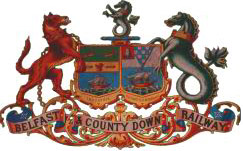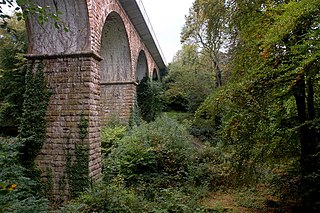
NI Railways, also known as Northern Ireland Railways, is the railway operator in Northern Ireland. NIR is a subsidiary of Translink, whose parent company is the Northern Ireland Transport Holding Company (NITHCo), and is one of nine publicly owned train operators in the United Kingdom, the others being Direct Rail Services, Caledonian Sleeper, Northern Trains, Transport for Wales Rail, Southeastern, LNER, ScotRail, and TransPennine Express. It has a common Board of Management with the other two companies in the group, Ulsterbus and Metro.

Rail transport in Ireland is provided by Iarnród Éireann in the Republic of Ireland and by Northern Ireland Railways in Northern Ireland.

Translink is the brand name of the Northern Ireland Transport Holding Company (NITHCo), a public corporation providing public transport in Northern Ireland. NI Railways, Ulsterbus, Goldliner, Metro and Glider are all part of Translink. It is led by CEO Chris Conway.

The Ulster Transport Authority (UTA) ran rail and bus transport in Northern Ireland that operated from 1948 until 1967.

The Belfast and County Down Railway (BCDR) was an Irish gauge railway in Ireland linking Belfast with County Down. It was built in the 19th century and absorbed into the Ulster Transport Authority in 1948. All but the line between Belfast and Bangor was closed in the 1950s, although some of it has been restored near Downpatrick by a heritage line, the Downpatrick and County Down Railway.

Belfast Lough is a large sea inlet on the east coast of Northern Ireland. At its head is the city and port of Belfast, which sits at the mouth of the River Lagan. The lough opens into the North Channel and connects Belfast to the Irish Sea.

Both the Ulster Folk Museum and Ulster Transport Museum are situated in Cultra, Northern Ireland, about 11 kilometres (6.8 mi) east of the city of Belfast. Now operating as two separate museums, the Folk Museum endeavours to illustrate the way of life and traditions of the people in Northern Ireland, past and present, while the Transport Museum explores and exhibits methods of transport by land, sea and air, past and present. The museums rank among Ireland's foremost visitor attractions and is a former Irish Museum of the Year. The location houses two of four museums included in National Museums NI.

Belfast Lanyon Place is a railway station serving the city of Belfast in Northern Ireland. Located on East Bridge Street in the Laganside area of central Belfast, it is one of four stations in the city centre, the others being City Hospital, Botanic, and Belfast Grand Central.

Bangor Bus and Rail Centre is a combined rail and bus interchange which serves the city of Bangor in County Down, Northern Ireland.

The Dublin-Belfast Line or The Great Northern Main Line(Dublin line by NI Railways and Belfast line by Irish Rail) is a 112-mile semi-electrified railway connecting Belfast Grand Central in Northern Ireland to Dublin Connolly in the Republic of Ireland. The key towns and cities of Skerries, Drogheda, Dundalk, Newry, Portadown, Lurgan, and Lisburn are situated along the line. The Dublin-Belfast Line is the busiest railway route on the island of Ireland, carrying a mixture of intercity rail, regional rail, commuter rail traffic and freight traffic. It is uniquely significant as the only railway line that crosses the Republic of Ireland–United Kingdom border.

Portadown Railway Station serves the town of Portadown in County Armagh, Northern Ireland.

Titanic Quarter railway station is located in the townland of Ballymacarrett in east Belfast, Northern Ireland. It is a short walk from the SSE Arena and Titanic Quarter.

Holywood railway station serves Holywood in County Down, Northern Ireland. It is located along the shore of Belfast Lough and during the Summer months, provides excellent views over the lough to Carrickfergus.

Marino railway station is a railway station in the townland of Ballycultra in Holywood, County Down, Northern Ireland.

Lurgan railway station serves Lurgan in County Armagh, Northern Ireland. Located on William Street. The station is managed by NI Railways. With just under 867,000 passengers boarding or alighting at the station in the year 2023/24 financial year, Lurgan is the 9th-busiest station on the NIR network.

The Belfast suburban rail commuter network serves the metropolitan area of Greater Belfast and some of its commuter towns with three lines. The network is owned by Translink and operated by its subsidiary NI Railways.
Transportation systems in the city of Belfast, Northern Ireland, include road, air, rail, and sea. It is still a relatively car-dependent city; however, it is also served by a comprehensive rail and bus network. Belfast also ran electric trams prior to 1954. The city has two major airports, and the Port of Belfast is the busiest ferry port on the island of Ireland.

Great Victoria Street was a railway station that served the city centre of Belfast, Northern Ireland. It was one of two main stations in the city, along with Lanyon Place, and was nearest to the city centre. The station was situated beside Great Victoria Street and shared a site with the Europa Buscentre, Belfast's former main bus station. The railway and bus stations were replaced by the adjacent Belfast Grand Central station with the official opening on 13 October 2024. Great Victoria Street railway station closed permanently on 10 May 2024, with a bus transfer service operating until rail services commenced from Belfast Grand Central, with a service to Dublin at 8:05 a.m. on 13 October 2024. Europa Buscentre closed permanently on 7 September 2024, with bus services immediately transferring to the new station, commencing with a service to Dublin at 5 a.m. on 8 September 2024.

Belfast Grand Central station is a railway and bus station in the city centre of Belfast, Northern Ireland. It has replaced Great Victoria Street railway station and the Europa Buscentre. It is built next to its predecessors, in a new neighbourhood called Weaver's Cross. The first bus service, to Dublin, departed from the station on 8 September 2024, and the first rail service, also to Dublin, departed from the station on 13 October 2024.

The Crawfordsburn Viaduct is a railway viaduct in Crawfordsburn, County Down, Northern Ireland.



























